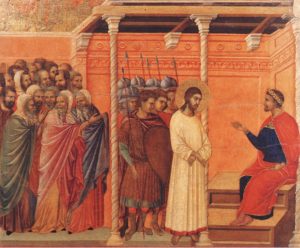Thoughts on Sunday’s Lessons for April 14, 2019
The Liturgy of the Palms C
Gospel: Luke 19:28-40
Palm Sunday and Passion Sunday fall on the same day in modern times, prompting us to watch in shock and surprise as the crowds who cheered for Jesus upon his arrival in Jerusalem quickly turn to mocking him and calling for his crucifixion.

Christ Before Pilate Again (1308-1311), tempera painting on wood by Duccio di Bunda (1255-1319). Museo dell’Opera Metropolitana del Duomo, Florence, Italy. (Click image to enlarge.)
First, in the Liturgy of the Palms, we celebrate and wave our palms as Jesus rides a colt into Jerusalem while the crowd chants the words of the prophet Zechariah celebrating the arrival of Israel’s king: “Rejoice greatly, O daughter Zion! Shout aloud, O daughter Jerusalem! Lo, your king comes to you; triumphant and victorious is he, humble and riding on a donkey, on a colt, the foal of a donkey!” Then Luke shows the crowd responding with a song of joy that we’ll hear again in Psalm 118: “Blessed is the one who comes in the name of the Lord!”
Psalm: Psalm 118:1-2, 19-29
This resounding ancient hymn, a song in celebration of victory, rings out in harmony with the first reading’s verses of celebration of Jesus’ arrival in Jerusalem. Imagine a joyful crowd at the gates to the ancient Temple, clapping hands and loudly singing, praising the Lord, our God, whose mercy and steadfast love endure forever. “On this day the Lord has acted; we will rejoice and be glad in it.”
The Liturgy of the Passion C
First Reading: Isaiah 50:4-9a
Now our readings turn darker and more painful as Holy Week draws near. But even as shadows and twilight fall, the hope that rests in faith and trust remains. The Prophet Isaiah surely meant the “Suffering Servant” figure as a metaphor for Israel under the iron foot of exile, hoping some day to return home with God’s help. Christians must respect this tradition, but the Servant’s pain may make us think of Jesus too, particularly in its clear call to turn the other cheek against our enemies, knowing that God is with us.
Psalm: Psalm 31:9-16
The darkness deepens as we hear this Psalm. These verses that echo the pain of the Suffering Servant remind us that numbing anguish can sap the strength of body, mind and soul. But even in the darkest depths, hope remains! Even when life seems full of pain and void of hope, we trust in God and pray: “Let your face shine upon your servant; save me in your steadfast love.”
Second Reading: Philippians 2:5-11
When Paul wrote this letter from a prison cell in Rome, he may have had Isaiah’s Suffering Servant in mind. In poetic verses that historians believe may have been taken from an early Christian hymn, Paul tells us that Jesus “emptied himself” as a human, even a slave, becoming one with us even in suffering. Jesus took on human frailty as he bore the gruesome pain of crucifixion. With this as our model, Paul shows that all are called to serve God and our neighbor humbly and obediently, becoming “more” through being “less.”
Gospel: Luke 22:14-23:49
Now the joy and celebration of the procession with the palms is fully turned. We see Jesus and his friends at the Last Supper, and now the crowds who had cheered for Jesus are mocking him and calling for his crucifixion. Before long we listen in horror to the familiar account of Jesus’ torture and gruesome death. In the midst of it all, though, take a moment to reflect on a brief passage at the Last Supper when Jesus turns the disciples’ bold ideas upside down after they started arguing about which of them was to be the greatest: “The greatest among you must become like the youngest,” Jesus tells them, “and the leader like one who serves.” What direction might we take from this? How are we called to serve?
